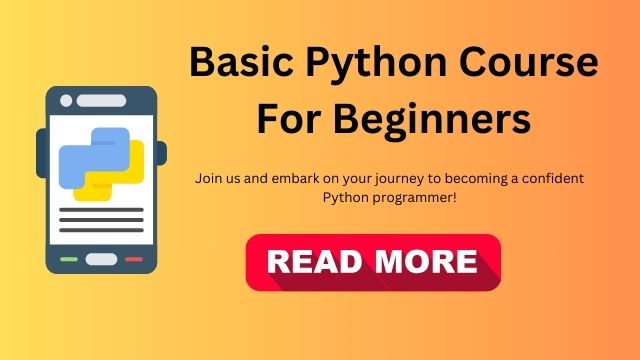Basic Python Course Outline For Beginners
Welcome to our Basic Python Course for Beginners! If you’re new to programming and looking for a structured way to start learning Python, you’ve come to the right place. This course is designed to guide you through the fundamental concepts of Python with clear explanations and practical examples. Whether you’re aiming to build a strong foundation in coding or just curious about how Python works, our course will provide you with the essential skills and knowledge to get started. Join us and embark on your journey to becoming a confident Python programmer!
1. Introduction to Python
Python Programming for Beginners:
- Objective: Understand what Python is and set up the development environment.
- Topics:
- Overview of Python
- Installing Python and setting up an IDE (e.g. VSCode)
- Writing and running your first Python script
- Example Exercise:
Write a simple script to print “Hello, World!” and run it.
Read More:
First Best Python Program for Beginners:
Python Programming for Beginners:
2. Variables and Data Types
- Objective: Video Content about Python’s data types and how to use variables.
- Topics:
- Data types: integers, floats, strings, booleans
- Variable assignment
- Type conversion (video Content:)
- Example Exercise:
Create variables of different data types and print their values and types.
Read More Detailed Articles:
Data types in Python:
String Data Types In Python:
3. Basic Operators
- Objective: Understand how to perform operations on variables.
- Topics:
- Arithmetic operators:
+, -, *, /, %, //, **
- Comparison operators:
==, !=, >, <, >=, <=
- Logical operators:
and, or, not
- Example Exercise:
- Perform arithmetic operations and comparisons with different operators and print the results.
Operators In Python Playlist Complete Guide:
4. Control Flow
- Objective: Learn to control the flow of a program using conditionals and loops.
- Topics:
- Conditional statements:
if, elif, else
- Loops:
for loops, while loops
- Loop control:
break, continue
- Example Exercise:
- Write a program that uses a loop to print numbers from 1 to 10 and prints a message if a number is even or odd.
5. Functions
- Objective: Understand how to define and use functions in Python.
- Topics:
- Defining functions with
def
- Function parameters and return values
- Scope and lifetime of variables
- Example Exercise:
- Write a function that takes two numbers as parameters and returns their sum. Use this function in a program to add numbers provided by the user.
6. Lists and Tuples
- Objective: Work with Python’s built-in data structures for storing collections of data.
- Topics:
- Creating and accessing lists and tuples
- List and tuple methods (e.g.,
append(), remove(), sort())
- List comprehensions
- Example Exercise:
- Create a list of your favorite fruits and perform various operations like adding and removing items. Also, create a tuple of numbers and access its elements.
7. Dictionaries and Sets
- Objective: Learn how to use dictionaries and sets for data storage and manipulation.
- Topics:
- Creating and accessing dictionaries and sets
- Dictionary methods (e.g.,
keys(), values(), items())
- Set operations (e.g., union, intersection, difference)
- Example Exercise:
- Write a program using a dictionary to store student names and grades. Implement functionality to add a new student, update grades, and display all students and grades.
8. File Handling
- Objective: Understand how to read from and write to files in Python.
- Topics:
- Reading from files
- Writing to files
- Working with file paths
- Example Exercise:
- Write a program that reads a text file and counts the number of words. Then, write another program that writes a list of strings to a file.
9. Error Handling
- Objective: Learn to handle errors and exceptions in Python.
- Topics:
- Using
try, except, finally
- Handling specific exceptions
- Raising exceptions
- Example Exercise:
- Write a program that prompts the user to enter a number and handles any errors that occur if the input is not a valid number.
10. Introduction to Modules and Libraries
- Objective: Get familiar with using external libraries and modules.
- Topics:
- Importing standard libraries (e.g.,
math, datetime)
- Using third-party libraries (e.g.,
requests, numpy)
- Understanding the
pip package manager
- Example Exercise:
- Use the
math library to perform advanced mathematical calculations and the datetime library to display the current date and time.

